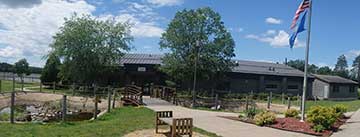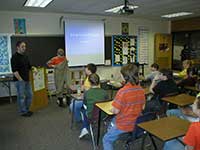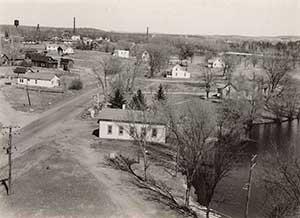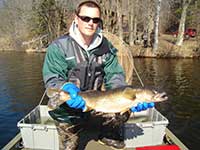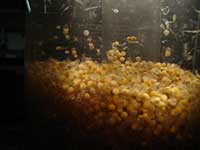Governor Tommy G. Thompson State Fish Hatchery
Fishing Wisconsin
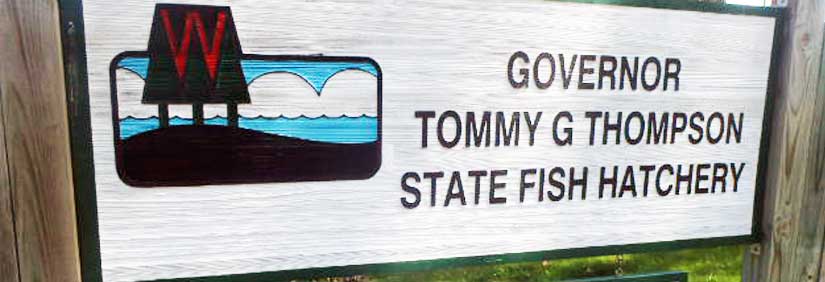
Hatchery Information
Governor Tommy G. Thompson Fish Hatchery is not only the state's largest cool-water facility but also the world's largest musky (muskellunge) hatchery. For many years, the hatchery produced more than half the muskellunge and walleye stocked throughout the state. With 46 rearing ponds, the facility may produce 200,000 to 2.5 million small walleye, 100,000 to 350,000 larger walleye, 35,000 to 60,000 large musky, and an average of 21 million white sucker fry in a typical year.
Hatchery hours
- Visitor Center is open Monday through Friday from 8 a.m. to 3 p.m. (Note: hours are subject to change without notice.)
- Guided Tours are provided the Tuesday after Memorial Day through the Friday before Labor Day
- Guided tours are scheduled on Tuesdays and Fridays at 10 a.m. and 2 p.m.
Amenities
- Visitor Center
- Conference room
- Picnic facilities near the hatchery
- Restrooms
- Fishing piers
Hatchery Location
951 West Maple St.
Spooner, WI 54801
Enter the hatchery from Highway 70 or enter Spooner Memorial Park from Highway 253/3 on the east.
Volunteering and Friends Group
Contact
Call (715) 416-8217 or email Jared Boucher.
Visiting
Visitor Center
The public is welcome to visit the visitor center year-round, where you'll learn about water ecology and fish rearing by viewing the incubators, rearing ponds, and educational exhibits.
The visitor center features an educational 24-foot mural painted by local artist Ruth King, a DNR non-point source pollution specialist. The mural depicts what happens in a lake above and below the surface.
From late April through October, observe the spring egg incubation operations and view the fall pond harvest before hatchery fish are stocked into Wisconsin's waters. See tour times under "Hatchery Information".
Spooner Memorial Park
Spooner's Memorial Park is located off Highway 253/63. Picnic facilities are available, and the hatchery is only a short walk away. The area below the Spooner Dam is excellent for fishing and has two handicapped-accessible fishing piers.
Three piers on the Yellow River Flowage, between Spooner Memorial Park and the hatchery, offer great fishing and handicapped accessibility. A boat launch, parking area and restroom facilities are also available on park property.
Education
The hatchery's mission includes raising fish to stock state waters and education. Students from area schools, Boy and Girl Scouts, community groups and tourists regularly visit the hatchery to learn about the process of collecting fish eggs in the wild. The eggs are then taken to the hatchery building to be incubated and transferred outside to 40 one-acre and six half-acre ponds.
History
Tucked along the banks of the Yellow River Flowage, the Gov. Tommy G. Thompson Hatchery has been raising fish and providing fisheries information to the public for over 100 years.
The original Spooner fish hatchery was built in 1913 and produced 36 million walleye in 1914.
A new hatchery was built in 1939 and 1940. With 29 earthen ponds, it was the largest hatchery in Wisconsin at that time.
The State Building Commission approved $10.5 million to renovate and rebuild the Spooner Hatchery on Sept. 15, 1993. In May 1994, the groundbreaking ceremony officially started constructing the new hatchery project.
Natural Resource Board renamed the Spooner Fish Hatchery the "Governor Tommy G. Thompson State Fish Hatchery." Operated by the DNR, the hatchery provides fish for many state waters and contributes to the state's fishing heritage.
Fish production
Hatchery workers collect, fertilize and transport eggs from the wild to the hatchery during the spring. After the eggs have hatched and grown, they are transferred outdoors to one of the forty-one-acre ponds or six half-acre ponds.
When the fish are ready to be stocked, the rearing ponds are drawn down to be netted or dipped out. The fish are loaded onto transport trucks, kept alive with compressed oxygen, and hauled to their stocking site.
Most walleye produced here are stocked in northern Wisconsin, but muskies are widely distributed from north to southern Wisconsin.
Walleye harvest
Learn more about the Wisconsin Walleye Initiative and where walleye are stocked annually.

